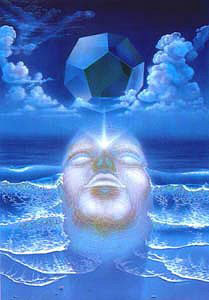
Under The Covers
In preparation for this composition, I considered a number of topics. What I found was that in many cases I had already explored them sufficiently, in whole or in parts of other essays, so that I have covered the ideas I thought to convey. While I continued to contemplate this week’s piece, several groups of thoughts collided together.
One of them came out of a conversation I had last week with a good friend, where I had suggested that maybe I should explore the way we perceive the world around us and how our perception triggers various thoughts, many judgmental or at least not clear and unconditionally loving. In addition, we chatted about how our mental blocks and filters are engaged in the observation and perception process. In turn this process can modify what we perceive and are aware of consciously. Hence, we can learn a great deal about ourselves by noticing what we think about as we observe. The thought I had at the time was to explore the idea that by noticing what we notice we actually start to change what we do notice. By doing this we will elevate our thoughts to a higher level.
The others occurred to me the other day, as I read some of my Facebook friends status updates. Two in particular caught my attention and had me smiling and commenting on them. One was a comment made by the person themselves regarding the words of a great teacher and the other a sharing of words of wisdom from Alan Watts. I will quote parts of what they posted them without referring to the posters themselves. They are as follows:
’Stuff’ is a word which describes the formless mush that we perceive when sense is not keen enough to make out its pattern. The notion of material or mental stuff is based on the false analogy that trees are made of wood, mountains of stone and minds of spirit in the same way that pots are made of clay. ~ Alan Watts”
“Last night I decided to do walking meditation, slow way down and notice how i place my feet, really feel my feet kiss the ground as Thich Nhat Hanh teaches. The familiar sights became more magical and I had a lovely neighbor stop and let her sweet German Sheppard give me a big kiss.
“I am what I think” is a phrase I spoke about in a previous composition, “Our Mental House Part 3: The Consequences of How We Think” (1), namely in terms of how what we think affects our relationship with the manifest Cosmos in which we find ourselves. If we believe the world to be one way, we tend to notice those aspects of it and not others. This is what I am referring to in the below passage from that piece:
”We have built a world that grabs our attention, one that holds it like a vice grip. To break the grip we need to summon our will, thinking about it is rarely sufficient. We need to change our relationship with the world and ourselves.”
The intent of this passage was to share the idea that it is not sufficient for us to think about this concept, we must act upon it, which brings me back to that conversation I had last week. What we do is we think about things, and our thoughts induce a reaction within our astral body, which we call an emotion. This interplay or dance is one that we do not noticed occurring, but the consequences of it, over the course of our lives, come to dominate our sense of who and what we are. This leads us to the belief that we are the thoughts and feelings we have, rather than these being aspects or the cloth, so to speak, our self wraps itself in during an incarnation.
Getting past this illusion takes time, but then this should surprise no one as it has taken time for the illusion to develop. As children, we do not think about this. During the first few years of our lives, we are busy exploring the world around us. Through our exploration, we have experiences and we react to them. This process is what creates our mental house. We cannot stop this, what we can do is change the way we integrate our experiences. Our children will not do this on their own, for we have been learning as we do now for millennia. We must come to an understanding about how our minds develop and then use our awareness of it to guide our children.
A large part of why I write what I do is not only so that others can learn, it is also so that they use this awareness to guide their interactions with others and especially with their children or any young person with whom they interact. I have spoken at length about the idea embodied by the Alan Watts quote at the start of this piece. Everything that exists, be it physical or otherwise, is merely energy or movement in relationships. Everything arose out of the movement of ‘space’, what we would call ‘No Thing’ which can be referred to as ‘the Unmanifest’(2).
Hence, trees, mountains or mind are made of movement or energy and not wood, stone or spirit. We come to this view because that is how they appear to us; however, we all know that appearances can be deceiving, and the appearance of what I refer to is the ultimate deception.

Not only does this deception affect how we think of virtually everything, it affects how we relate to everything. When we look at others, we appear separate when we are not, certainly not in the sense that we tend to imagine. What we do has the potential to affect everything else, the reason it does not is that ‘everything else’ has its own ability to self-determinate. Still, we are part of what some refer to as ‘the web of life’ and so the potential remains.
Your thoughts about me can influence me; however, they cannot determine what I will or will not do if I choose otherwise. The problem is that so few of us exercise our right to choose. We have lost control over our own minds, which we allow to take over this responsibility from us. The most significant reason this occurs is we base our view of ourselves, as well as our ‘reality’ around ideas such as our separateness, that thoughts are not things and that we are our physical selves. We can even think otherwise, but ‘thinking is not knowing’ in the truest sense. This is similar to how there is only now, despite the illusion of time. Unless one experiences the now in more than a passing way, it remains a concept, not an actuality.
The challenge for us all is to see through the illusion, to train our minds so that it is transparent and in so doing we allow the now to be and time, as we know it ceases. I developed The Twin Powers material to help us do this. In order for this to happen consciously, we need to deconstruct the illusion we have manifested. It will not, or is not likely to happen by accident. We must become aware of the nature of our mind, what thoughts and emotions are and begin to see that they are not us; they are the clothes we wear. If we allow them to determine our reality for us, then we remain caught in the illusion.
From “The Limiting Aspects of the Rational Mind (RM)” (3)
“One barrier that is not obvious is a consequence of the nature of our existence, and our minds focus on the physical realities of life. We build our rational minds on the foundation of our own logic, that which comes out of our reactions to experiences. For instance, the mind does not need to prove a premise as true, it only has to believe it to be true. As a result, we rely almost entirely on interpretation of what we perceive through our physical senses and the mind becomes deeply rooted in the concepts of linear time and 3-dimensional space. This view of reality can be a very real barrier when one tries to develop their spiritual side.
The spiritual view of a conscious universe runs somewhat contrary to the space-time view where our minds cling to the idea of “things”. Everything is energy, and perception. Luckily, our higher awareness is not so dependent or limited, it can transcend time, perceives energy not things, and is unaffected by space or distance. The rational mind gets tired after a day’s work as we access it primarily through our brain, and our brains get tired. These restrictions do not apply to our higher awareness as it is not a result of our physicality.”
There is no getting away from the need for our mind; we cannot function here without it. What we need to do is renovate our mental house. We can do this in many ways; some methods being more active than others are. Active methods would include meditation, deliberately focused attention, counselling or working with someone to help us get at the issues we have taken on. Passive methods would be those that work all the time, most are based on creating thought forms that form the foundation of a new view of reality and us.
Many of the mistaken notions and beliefs we have are subtle, hard to detect. They exist virtually unnoticed by us because we tend to live with the confines of the walls our thinking has created. Therefore, we do not encounter them as we go about our daily life even though their influence can be pervasive. For instance, we may believe that all is energy and everything is connected; however, our minds rarely see it that way.

To illustrate it to yourself, stand about 10 feet from a wall, with your arms at your side and close your eyes. Imagine that everything is energy, everything is connected and that you can see the energy that is the wall in your mind’s eye and feel that energy ahead of you. Once these thoughts are firm in your mind and you feel committed to them, begin to walk in small steps towards the wall with your eyes closed, and arms still at your side. Keep the thoughts I mentioned firmly in mind as you walk and remind yourself that, at the pace you are going, no harm will come to yourself.
Now, as you do so, you will likely begin to have thoughts about how far away the wall is, about banging into it or even find yourself wondering if will it hurt when you bump into it (as you do not have your hands in front of you to prevent you from banging your nose into the wall). You will feel some trepidation, uncertainty or other such thoughts, perhaps you will notice your steps becoming more reluctant and shorter the closer you come to where you think or imagine the wall to be.
Now you may say that these are natural, since one will eventually run into the wall and bang their nose. However, we know that we are taking small steps and even if we do bump into the wall, it is highly unlikely that we will be hurt. Such a minor concern should not be the focus of our attention, hence, our trepidation is unfounded, and our uncertainty the result of poor programming of our minds. Hence, even though you may think that everything is energy, that everything is connected, you likely cannot get past the idea that you will bump into the wall.
All of these thoughts are the result of various conflicting notions we hold about the nature of reality and us and our uncertainly about it. They are a clear indication of the ‘programming flaws’ within our mind. We should know that we are not going fast enough to hurt ourselves and hence should be able to give ourselves up to what we imagine. Yet, we cannot or at least it is very hard to avoid the thoughts I mentioned. These are subtle and pervasive thoughts, and are ones that make it very difficult for us to become transparent.
Fortunately, they are also ones we can work on passively while we take other steps to deal with our bigger issues. Certainly, we can work on these thoughts in meditation, and should; however, this is not our only means of dealing with them. In addition, with our busy lives we may not be able to make the time to do so. This is where passive actions can help us.
Let me be clear, by passive, I do not mean casually, or intermittently or without much intent behind them. By passively I mean that we are not being forceful with them. In a way we are treating them more as nouns rather than verbs. We are not challenging other the thoughts we have with them, though this invariably happens because we are trying to change the thoughts we have had and are having now. We are simply having a particular thought and are not concerned about other incongruous thoughts we may have. I covered a passive method, though I did not refer to it as such, in the essay “One Thought” (4) and again in “Sssh, It’s a Secret” (5). In these essays, respectively, I stated:
“Do not underestimate the power of a single thought or idea. That one thought I following through with had a huge impact, though it took several years for it to manifest. While I continued to struggle, that thought had a ripple effect. I began to find it easier to be less negative, less judgmental. This permitted me to apply both of these to myself as well resulting in my generating less emotional baggage each day - the knot started to unravel.” (4)
And,
“Our minds need to be clear, our thoughts unambiguous, in order for us to begin to manifest outcomes that we consciously choose.” (5)
One thing about today’s social media is that it inundates us with the thoughts and ideas of others. There are many who post positive affirmations, a form of passive thoughts, in the hope that they will stir one to consider them, if only for a moment. The problem is not that the message is wrong; it is that many contain unclear or conflicting messages and there are so many that each one only takes us with them for the moment before another one grabs our attention. Nor is the problem with those who send them out, even if they do so in large volumes. The challenge is to determine which passive thoughts to enable. We do not want to try to focus on too many because it is better to focus more fully on one or two. Also, we want the thought to be one that is clear, unambiguous and in harmony with not just us but the Cosmos as well.
It all boils down to mindfulness, which is why I included the second of the two quotes at the beginning of this composition. We allow our minds to do what they do and take much of their activities for granted. This takes us further and further from ourselves. The quote suggests we can come to a new understanding about ourselves simply by noticing what we tend to ignore, in this case, how we place our feet and the feel of our feet meeting the ground beneath us. This act helps us to let go of the thoughts that tend to dominate our minds and attention, these being the wants and needs we have accumulated throughout our lives.
We tend to think we are in control, that our thoughts are the result of ‘thinking’ when this is generally not the case. The majority of our thoughts are the result of how we have programmed our minds to react to what we experience and are automatic. Acts such as paying attention to our steps help us to notice and get away from doing so if only for a short period. It seems a simple act, but it took us a long time to learn how to walk.
Try it right now, get up out of your chair and take a step, doing so very slowly. Notice your thoughts about walking and the motions you make to do so. Notice how you lift your upper leg, while keeping your lower leg back, then extend the lower leg, shift your balance and allow the momentum of your movement to carry you forward. Then you straighten your lower leg and gravity takes over so that your heel meets the earth.
This act takes many thoughts to do, yet we do it automatically, without consciously thinking about it. How many other things do you we do in a similar fashion? Consider that even though you are not conscious of such thoughts, they occur all the time. It still takes thoughts to make this happen. The fact you are not thinking about it does not mean they do not happen.

Now, we do this as we walk, talk, pick up a pen, write, type or even turn to look out the window. We do these without thinking about how we do them. We have a simply thought and fail to realize just how many other thoughts that one simple thought enables. These examples involve little judgement, as most are not positive or negative. However, we allow our minds to do this with everything we experience.
When we are out and about, we experience the world around us, which includes the people we encounter. Just as we are not aware of the thoughts involved in taking a step, we are not aware of the blocks, filters and stereotyping that our minds engage in when we observe others. You have heard that reality is an illusion, well, our lack of mindfulness is a arguably the most significant reason why and how our minds create the illusion. We certainly need to allow our minds to do many things automatically; the problem is that we allow it to do too much this way. We see someone and before we think of them consciously our mind has automatically categorized them and made determinations about them. The only way to get past this is to start to notice how we observe just as I suggested we observe what goes on with each step we take.
When the mind stereotypes it does not use reasoning and rationality, it bases thoughts on what was, not what is. Do you remember learning how to walk, talk or even move your hand? Of course you do not. It just "happened" and then you could do it. This programming occurred automatically, as I have spoken of in numerous essays. It happens under the covers and out of the sight of our conscious attention. We do not pay attention so our mind carries on without our conscious guidance. This is how we come to learn to stereotype and where our blocks and filters come from as I spoke to in the essay “The Limiting Aspects of the Rational Mind” (3).
“A good example of how our mind handles new experiences is in how people tend to rely on first impressions of people, often mistakenly believing that first impressions are accurate, and then holding onto these first impressions as if this were so. When we first meet someone, the mind seeks to categorize them. In order to interpret the new person it searches for commonalities with previous experiences and links these to the new person.
We do this for perfectly natural and innocent reasons as well. Now, if the person is wearing certain clothes, the mind will associate them with others who have worn similar clothes thereby affecting your thoughts about the new person. It factors in other commonalities such as the situation, location, their overall appearance, gender, race, culture, age and so forth. Now, if we are agitated at the time and our senses are on alert for potential issues, some factors will become more important, and others less so. It does not mean that the factor is more important, only that at the time our mind tells us it is. Our initial thoughts seem real to us and they will remain in place unless we recognize this and make the conscious choice to modify them, or future experiences has us changing them.”
Walk into a store, while noting your own mood and feelings at the time and observe the people there. Do not stare at them, simply look and try to notice how you react to what you observe. What thoughts do you have about them? Are they negative or positive? There is a connection between our state of mind and our perception of others. We do not view them as they are; we view them based on our interpretation of them. We exert far less control over our interpretation of them than we believe.

Further, we should ask ourselves why we feel the need to judge them in the first place. We likely do not know them, their lives have little or no impact on our own, and they are not a threat of any kind. We do so automatically because of the needs we have developed over time. For example, if we are in a hurry, we will view them negatively and think negative thoughts about them if they appear to be slowing us down. We may get impatient when they appear to be taking too long to get their wallet out, are asking too many questions or simply seem to be in no hurry at all. This is similar to how we are often inclined to judge others as we feel others have judged us.
You have heard that people see flaws in others that they have in themselves. When we do not like something about ourselves, we are more inclined to notice this same flaw in others. So, turn this around and consider if we focus on the good qualities we have, we are more likely to notice them in others. Even further, if we are in a good place internally, loving, patient, compassionate and so on, then we are more likely to be so with others. Every bitter, angry, hurt or frustrated person I have ever met, and this applies to me when I have had such thoughts and feelings, lacks the ability to see people in a good way. These thoughts and feelings become the lens through which we view the world.
When we meet
Discard your regards for me
Gaze on me anew
See me as I am
The first exercise on The Twin Powers website is intended to get people to examine their own beliefs, not just about simple things, but about the nature of consciousness, awareness and our perception of the ‘reality’ we find ourselves in. What we believe about the nature of us and the Cosmos within which we live (our reality) are core thought constructs that affect everything we think and hence our feelings.
Going back to the quotes that sparked this essay, just as we tend to think trees are made of wood we also tend to think we are separate from others even if we believe that we are all one. Our physical separateness is a prime source of this thought form, just as the fact that most of cannot walk through wall or levitate. Everything is energy, and energy is merely movement, so “things” are comprised of relationships between movements. Our mind may hear the idea that we are all one and that all things are connected; however, the minds perception of experiences teaches it otherwise. Alan Watts suggested that this is because our sense is not keen enough to make out the pattern, I would suggest that it is our mind that does this due to expedience (lumping things together makes them easier to understand) and our external focus on doing rather than being. Perhaps this is what Alan meant, I cannot say, but this is why I added in the quote about the walking exercise.
The walking exercise helps us to reconnect to core thought forms and experience reality as a child with the reasoning skills and power of thought of an adult. It helps us to put aside the endless chatter of the mind and perceive reality more as it is in the moment rather than a stylized or conceptual version of it. This too is of great value for those seeking to develop their awareness or to shed the ego and see past the illusion. When we apply this along with the realization that there is only energy, we can see how much our mind glosses over things to make it easier. Unfortunately, doing so increases the strength of the illusion.
If we can start to do both of these things, we begin to perceive the world around us in a new way. Doing so reduces our tendency to judge, which in turn means our thoughts become more positive and the emotions we feel are of the higher variety rather than the lower. What we want to do is to be less subjective and superficial in our observations, and to reduce the tendency to erroneous reasoning. The latter happens, for example, when we start to have thoughts about ‘why someone is the way they are’. Since we do not know, presuming is a waste of time and effort and is counter-productive.
By doing these things, we can observe that someone who appears to be blocking us or who bothers us as someone struggling with their own life issues. I touched on this as well in the previous essay titled “Who’s In Control” (2) when I stated:
“We look at our errors, or wrongs, as mistakes, ones that show we are imperfect. However, as Mr. Leadbeater explains, our mistakes are the result of ignorance, and our ignorance, as I explain is the result of how we integrated our experiences. This is precisely what is meant by “should have, could have, would have”.

Remember that when you judge it is because you feel judged and react in kind. Take a moment everyday to reconnect to yourself through whatever means works for you. I offer and share suggestions about this but in the end it is you who has to find a way that works for you. They are not answers in and of themselves; they are merely ‘food for thought’.
A Cover
What do you think
When you open your eyes?
Bet you don't see half of it,
And half of it is `lies'.
(know what I mean?)
You move through it
One dancer in a play
I hear you `a speaking
Ever listen to what you say?
Chorus
You see what you want to
Hear what you want to hear
But, it's only window dressing
A cover for your fears,
Just cover for your fears.
Take the time - wonder
- what it's all about.
Are we gods in the making
Or just people full of doubt.
(what's it all about?)
I can lend a hand
Show you what I know
But, in the end, my friend,
You choose where you'll go
© 2012 Allan Beveridge
Last Updated Jan 13, 2020
References (*- denotes essays only available to site members of TheTwinPowers.com):
